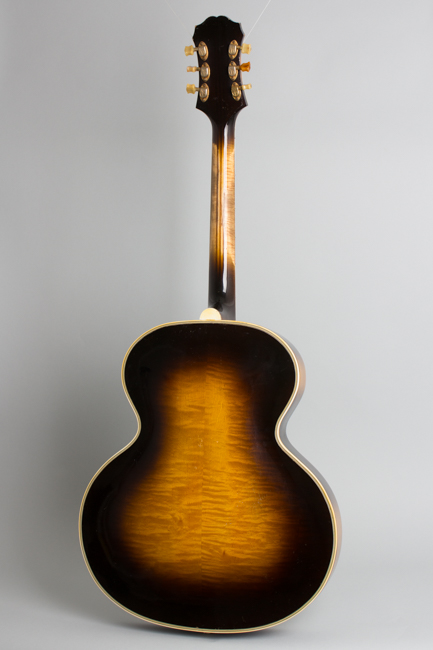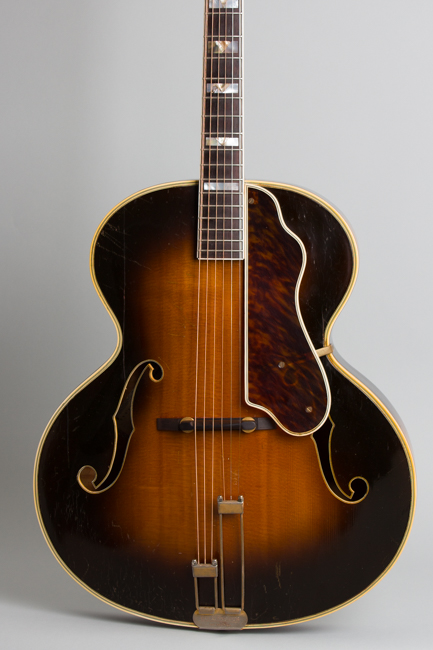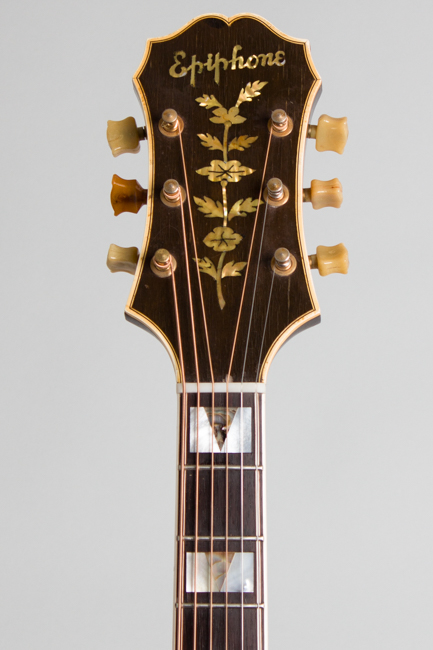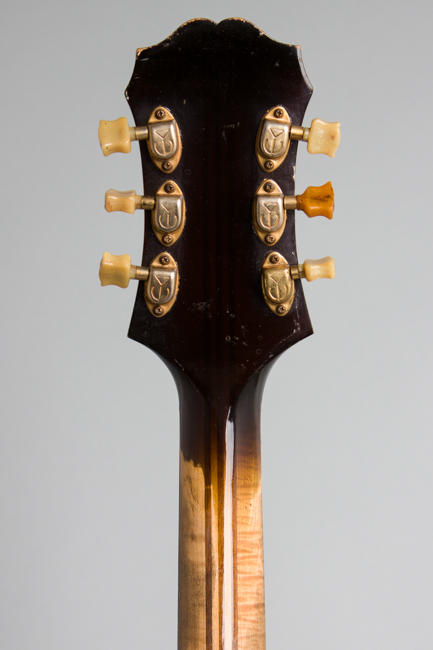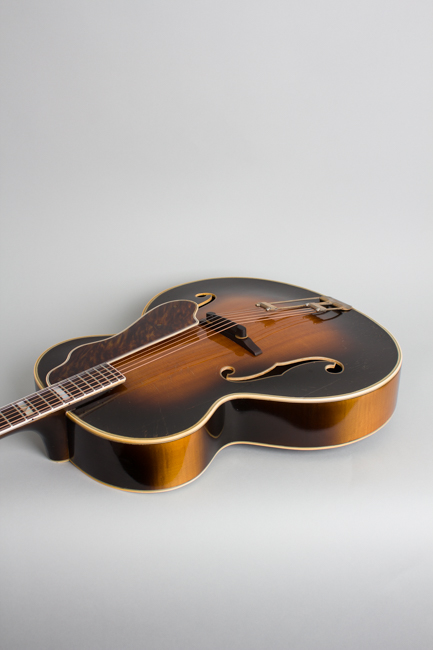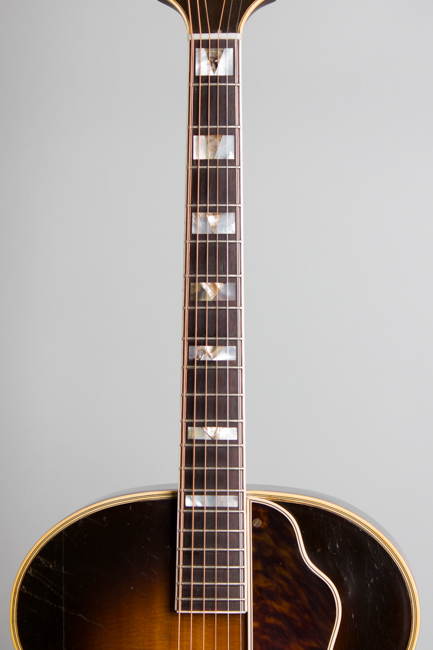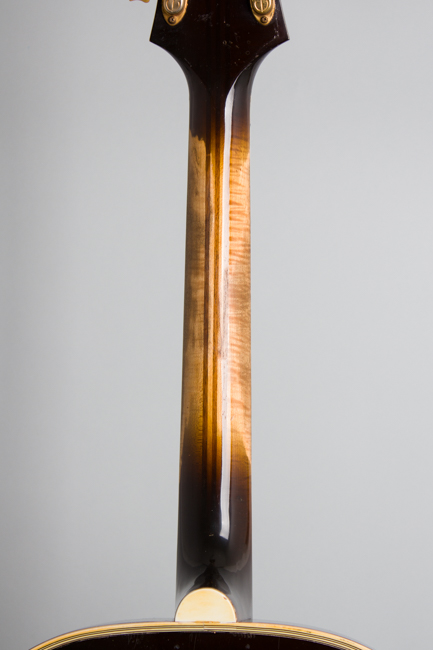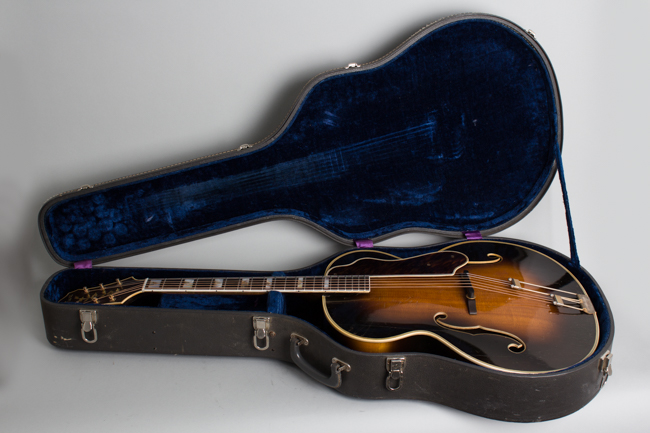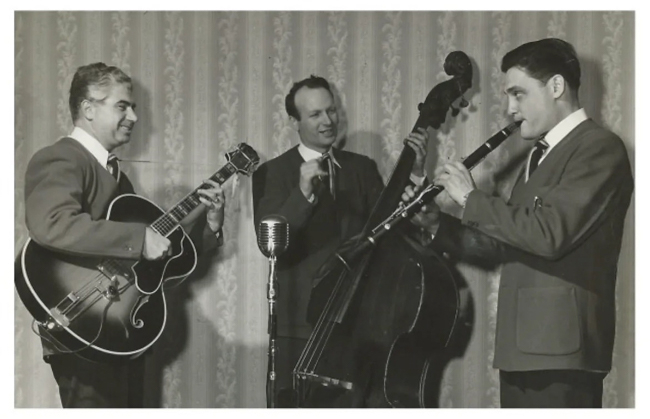Epiphone Emperor Arch Top Acoustic Guitar (1946)
Epiphone Emperor Model Arch Top Acoustic Guitar (1946), made in New York City, serial # 55706, sunburst lacquer finish, flame maple back and sides, spruce top; laminated maple neck with rosewood fingerboard, grey tolex hard shell case.
This is a fine playing example of a just post-WWII Epiphone Emperor, the original New York company's top of the line acoustic instrument. This guitar is one of a substantial number of Emperors ever made in 1946, when the Epiphone company was apparently catching up on backlogged wartime orders. The big-band era was coming to an end, but demand was still high for these full-bore acoustic archtops with the power to drive an entire orchestra.
The Epiphone Emperor was developed in 1935-36 as the company responded to arch-rival Gibson's newly "Advanced" archtop line. After Gibson launched the ultra-fancy 18" Super 400, Epiphone responded in kind with an even larger than 18" wide guitar at the same level of opulence. With a $400 price tag, these models were only affordable to the best professional users, and through the swing era Gibson and Epiphone vied to entice the top name players to feature them. Evidence suggests that the Emperor may well have outsold the Super 400 at the time. Original high-end acoustic archtop Epiphone guitars were very popular among professional users when new, but nice examples can be surprisingly hard to find today.
The body is a full 18 5/8" wide, made of figured maple and fine-grained spruce with too many layers of binding to count! The neck is a multi-laminate of maple and walnut, with a figured rosewood fingerboard, triple-bound and ornamented with pearl and abalone split blocks. The headstock is also triple-bound and inlaid with the "tree of life" pearl pattern that was an Epiphone trademark. The tailpiece is the two-tine Frequensator particular to the company as well.
This guitar has the typically huge Epiphone tone; you could easily drive a band with it! While the guitar has a lot of power it has a subtler side as well, with a mellower tone than some when played lightly, and is an excellent chord/melody machine as well as a very fine all-around archtop. The picture here is of the original owner; we don't have his name but he sure looks pretty happy with the guitar!
Overall length is 44 in. (111.8 cm.), 18 5/8 in. (47.3 cm.) wide at lower bout, and 3 1/4 in. (8.3 cm.) in depth, measured at side of rim. Scale length is 25 1/2 in. (648 mm.). Width of nut is 1 5/8 in. (41 mm.).
This is a fine playing example of this majestic instrument, showing wear and some typical repair but structurally excellent. The deep sunburst finish has some typical checking and scratches, dings and dents overall, most notably to the top. There are no large areas of finish loss except to the back of the neck which is worn down to the primer and wood over a decent part of its length.
The top has a long spruce grain split from the front edge to the top of the F-hole on the bass side, with a second split above running from the inner curve of the upper bass bout not through to the F-hole itself. A third small grain split can also be seen on the top forward of the treble side waist. All are solidly sealed but visible, with some minimal touchup in spots. The rest of the guitar is crack free.
The hardware is mostly original. The original Frequensator tailpiece has a tiny stress mark at either corner of the bend in the baseplate but is otherwise solid with no repairs. The multi-bound celluloid pickguard and bracket are original, with one ancient extra screw set into the lower curve which would have once secured a pickup control box. The "vampire bites" from a DeArmond bracket are visible on the top edge of the fingerboard extension. The bridge is more recent, nicely carved from ebony in a vaguely D'Angelico-esque pattern. The "E" logo tuners are original; one button is shrunken up a bit but still solid, another missing the securing screw but still tightly seated on the post.
All the elaborate layers of multiple binding are solid; there is some light shrinkage in a few spots, but none of the heavy deterioration many period East Coast guitars now suffer from. The neck has been neatly reset and the fingerboard trued and expertly refretted making the guitar an excellent player with the expected huge sound. It resides in a 1960's Gibson-made blue-lined grey tolex Epiphone HSC. Overall Excellent - Condition.
This is a fine playing example of a just post-WWII Epiphone Emperor, the original New York company's top of the line acoustic instrument. This guitar is one of a substantial number of Emperors ever made in 1946, when the Epiphone company was apparently catching up on backlogged wartime orders. The big-band era was coming to an end, but demand was still high for these full-bore acoustic archtops with the power to drive an entire orchestra.
The Epiphone Emperor was developed in 1935-36 as the company responded to arch-rival Gibson's newly "Advanced" archtop line. After Gibson launched the ultra-fancy 18" Super 400, Epiphone responded in kind with an even larger than 18" wide guitar at the same level of opulence. With a $400 price tag, these models were only affordable to the best professional users, and through the swing era Gibson and Epiphone vied to entice the top name players to feature them. Evidence suggests that the Emperor may well have outsold the Super 400 at the time. Original high-end acoustic archtop Epiphone guitars were very popular among professional users when new, but nice examples can be surprisingly hard to find today.
The body is a full 18 5/8" wide, made of figured maple and fine-grained spruce with too many layers of binding to count! The neck is a multi-laminate of maple and walnut, with a figured rosewood fingerboard, triple-bound and ornamented with pearl and abalone split blocks. The headstock is also triple-bound and inlaid with the "tree of life" pearl pattern that was an Epiphone trademark. The tailpiece is the two-tine Frequensator particular to the company as well.
This guitar has the typically huge Epiphone tone; you could easily drive a band with it! While the guitar has a lot of power it has a subtler side as well, with a mellower tone than some when played lightly, and is an excellent chord/melody machine as well as a very fine all-around archtop. The picture here is of the original owner; we don't have his name but he sure looks pretty happy with the guitar!
Overall length is 44 in. (111.8 cm.), 18 5/8 in. (47.3 cm.) wide at lower bout, and 3 1/4 in. (8.3 cm.) in depth, measured at side of rim. Scale length is 25 1/2 in. (648 mm.). Width of nut is 1 5/8 in. (41 mm.).
This is a fine playing example of this majestic instrument, showing wear and some typical repair but structurally excellent. The deep sunburst finish has some typical checking and scratches, dings and dents overall, most notably to the top. There are no large areas of finish loss except to the back of the neck which is worn down to the primer and wood over a decent part of its length.
The top has a long spruce grain split from the front edge to the top of the F-hole on the bass side, with a second split above running from the inner curve of the upper bass bout not through to the F-hole itself. A third small grain split can also be seen on the top forward of the treble side waist. All are solidly sealed but visible, with some minimal touchup in spots. The rest of the guitar is crack free.
The hardware is mostly original. The original Frequensator tailpiece has a tiny stress mark at either corner of the bend in the baseplate but is otherwise solid with no repairs. The multi-bound celluloid pickguard and bracket are original, with one ancient extra screw set into the lower curve which would have once secured a pickup control box. The "vampire bites" from a DeArmond bracket are visible on the top edge of the fingerboard extension. The bridge is more recent, nicely carved from ebony in a vaguely D'Angelico-esque pattern. The "E" logo tuners are original; one button is shrunken up a bit but still solid, another missing the securing screw but still tightly seated on the post.
All the elaborate layers of multiple binding are solid; there is some light shrinkage in a few spots, but none of the heavy deterioration many period East Coast guitars now suffer from. The neck has been neatly reset and the fingerboard trued and expertly refretted making the guitar an excellent player with the expected huge sound. It resides in a 1960's Gibson-made blue-lined grey tolex Epiphone HSC. Overall Excellent - Condition.


